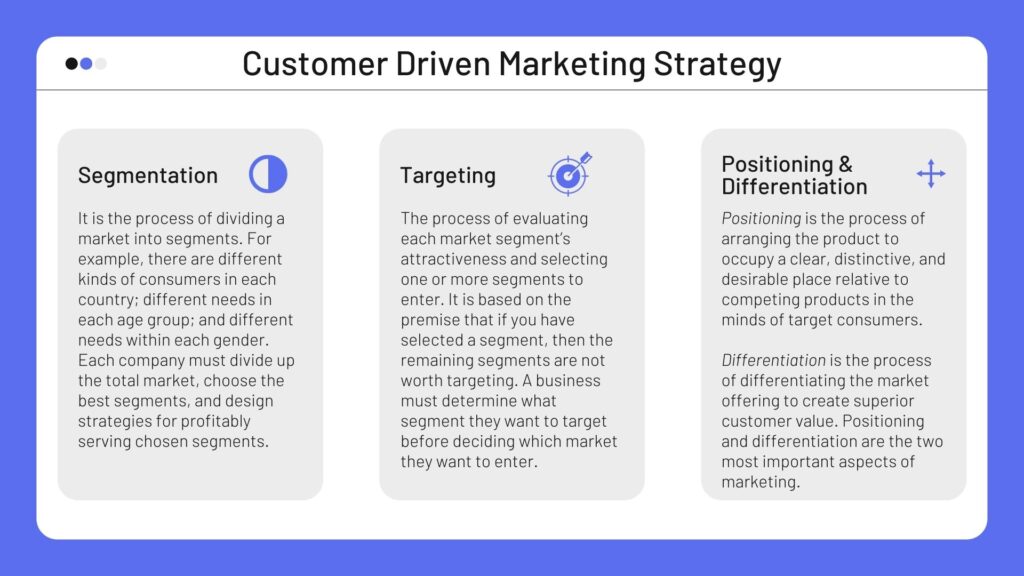Introduction
Marketing strategy is the process by which the company hopes to create customer value and achieve profitable customer relationships. Before you can satisfy your customer’s needs or wants, you must first know what they are so that you will be able to give them something valuable in return for their money. Thus, marketing strategy requires careful customer analysis and understanding of customers’ needs.
What is a customer-driven marketing strategy?
Companies know that they cannot profitably serve all customers in a given market. There are too many different kinds of consumers with too many different kinds of needs. Thus, each company must divide up the total market, choose the best segments, and design strategies for profitably serving chosen segments. It is the process by which companies decide how they will reach their target markets with messages designed to satisfy customer needs or wants through offering products and services at prices that are appealing enough so that potential customers will buy them.
It includes decisions about where, when, how often, and how much you will spend on marketing in order to build market share. Customer feedback through email, blog comments, social media, live chat, etc., is very pertinent for marketers to understand target customers and design better customer experience/customer service. The in-depth understanding of buyer persona through market research helps the marketing team to get a 360-degree view of your customers and build better products for the target audience. This results in increased brand loyalty, better brand reputation, satisfactory customer support, higher word of mouth marketing, etc.
What are the four steps, in order, to design a customer-driven marketing strategy?
The four steps are market segmentation, market targeting, differentiation, and positioning.

Market segmentation
It is the process of dividing a market into segments. For example, there are different kinds of consumers in each country; different needs in each age group; and different needs within each gender. Each company must divide up the total market, choose the best segments, and design strategies for profitably serving chosen segments. Market segmentation requires an understanding of customers’ needs or wants by looking at demographics (age, sex), psychographics (lifestyle preferences), attitudinal attributes (value systems), and behavioral attributes (habits). Once you have identified your target customer base, you must then choose the best segments for your company. These are customers who have similar psychographic attributes, attitudinal attributes, and behavioral habits that create value for your business. A market segment is a group of consumers who respond in a similar way to a given set of marketing efforts.
Example:
People who want “Value For Money” (VFM) mobile phones can be one market segment. Then, it will be difficult to attract this market segment with a premium phone like iPhone. Therefore, companies must be wise to focus their marketing efforts to address the needs of each individual segment.
Market Targeting
The process of evaluating each market segment’s attractiveness and selecting one or more segments to enter. It is based on the premise that if you have selected a segment, then the remaining segments are not worth targeting. A business must determine what segment they want to target before deciding which market they want to enter. Otherwise, they will spend too much money on marketing without getting any return on investment (ROI). Most companies enter a new market by serving a single segment; if this proves successful, they add more segments. Large companies eventually seek full marketing coverage. The number of segments and the degree to which each segment is targeted vary with the market size. The more segments a company targets, the higher its marketing cost becomes, but it may also be able to achieve greater ROI by targeting fewer segments.
Example:
McDonald’s (MCD) targets its food service to children between the ages of 3–12. If it did not target this segment, then a lot of money would be spent on marketing to reach a broader audience. But attracting children, attracts their parents, thereby increasing the average order value (AOV) spent on their restaurants.
Positioning
It is the process of arranging the product to occupy a clear, distinctive, and desirable place relative to competing products in the minds of target consumers. It involves the positioning of a product within a market, and is determined by several factors:
Size and scope of the market:
The larger the size and scope of the target market, the more difficult it will be to position your product in relation to competing products;
Competitive situation:
If there are no competitors in this particular segment, then you can create an entirely new position for your product;
Price-value relationship:
If you offer a better value than its competitors or if it is less expensive than other products that occupy similar positions, then you can effectively differentiate yourself from them;
Brand name recognition:
If your brand is well known, then you can use this as a differentiator from other products that occupy similar positions;
Value perceptions:
If people perceive the product to be of high quality and value for money, then they will buy it regardless of its price or competitive position in the market;
Example:
BMW – The Ultimate Driving Machine.
Differentiation
It is the process of differentiating the market offering to create superior customer value. Positioning and differentiation are the two most important aspects of marketing. Both have a significant impact on how well a product is perceived by consumers, which can result in higher sales. Differentiation is a key to competitive advantage, and it’s usually based on market segmentation or an existing product category.
The differentiation can be direct (i.e., by improving quality) or indirect (i.e., through improved positioning). Differentiation is especially important in industries where there are numerous competitors with similar products, such as consumer electronics and automobiles; companies must differentiate their offerings from those of other brands to gain a competitive edge. This may involve establishing differentiating characteristics that make a product or service stand out from the competition.
Differentiation is not always based on quality, as some products can be differentiated by offering a superior value for money. For example, Tesco sells groceries at very low prices and with good service to achieve high levels of customer loyalty; it can then sell other goods that are more expensive than competitors’ at the same time (for example, fashion clothing). Another way to differentiate products is through brand name recognition; this may require significant investment in marketing efforts.
Conclusion
A customer-driven marketing strategy is the most effective way to increase sales, brand loyalty, and customer satisfaction. The strategy helps companies find the customers who are likely to buy their products or services, then uses all kinds of communication methods to get them into buying mode. It is essential for every business to use a customer-driven marketing strategy. It is not a new concept. It has been around for years, but it is still one of the most powerful strategies to take your business to the next level. The four steps outlined in this blog are effective at building strong customer relationships and can be used by companies across industries.
